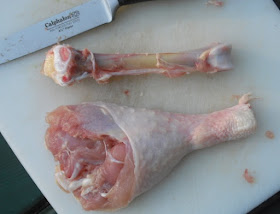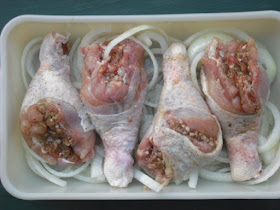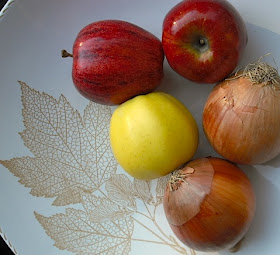 |
| Simple. Basic. Classic. |
Whenever my grandmother babysat, we were guaranteed two foods: potato pancakes (latkes) and dumplings (
Kreplach). To this day, nothing instills greater excitement in my family than the promise of those two foods. Our tongues literally quiver in anticipation. As Catholics, potato pancakes were a given on Friday, the day of no meat. They were certainly economical, but time-consuming in their preparation. My mother labored with a mountain of potatoes to grate.
I deviate from my mother's and grandmother's recipe in three ways: I drain the potatoes after shredding which allows them to cook quicker and crisper and less mushy in the center. I fry them in peanut oil. My mother and grandmother got out the can of Crisco and melted great mounds of the white stuff. I've also used olive oil, but peanut oil can withstand high temperatures without burning and smoking. I also now use two grates: one small and one large with is more visually appealing and which gives a really great "crunch" to the outer edges.
 |
| Wonderfully crunchy on the outside, warm and soft on the inside. Kids love them. |
Sorry, but a blender of food processor just doesn't cut it when grating potatoes for latkes. It's a labor of love and best done by hand. The small holes on a box grater are too small and will result in a mush. You want about five grating holes to an inch. Yes, you should measure.
My mother and grandmother used this simple grater for potato pancakes. I wish I would saved either or both when they passed because I recently purchased one and the poor quality tells me it won't last very long!
Through the years, I have accumulated a number of graters just for this recipe. I like my latkes crunchy on the outside and perimeter, but a bit softer in the middle. For those who are thinking these are nothing more than a smashed tater tot or McDonald's hash brown, move on. Not even close!
But, it you and your family loves authentic has browns, this recipe is for y'all!
With a salad and a side of fruit, these can be a meal in themselves. Traditionally, they are served with sour cream or applesauce. They go well with any wine, but I still prefer a tall, cold glass of milk. They also pair with smoked sausages or leftover ham. Smoked salmon is over the top! I just love them with butter and salt. My mother loved them with cottage cheese.
These are great for an appetizer. Also good when you need some kind of a vegan dish. Just fry in any type of animal fat or oil that has a high smoking point.
Historically, they should be fried in chicken fat, but it is insanely expensive to buy, let alone find.
 |
| Notice the crispy, crunchy edges as a result of using two sizes of grating. |
As a young teacher, these saved the day for dinner. They were less expensive than pancakes which I often made (with hot dogs). Potatoes were cheaper than flour. And, yes, back then I used shortening for frying. Butter and salt were cheaper than syrup. A tall glass of cold milk and I was filled and happy ready to grade a mountain of students' papers . . .
Makes about 14-16 pancakes
- 1.5 - 2 lbs. Idaho potatoes, peeled
- 1/2 of a small onion, about 4-6 oz. leave root end intact
- 1.5 tablespoons all-purpose flour or, if you have it, potato flour
- 1 large egg, sightly beaten
- 1+ teaspoon Kosher salt
- A few shakes all-purpose black pepper
- Peanut oil for frying. Chicken fat (schmaltz) is even better. Or duck fat.
Preheat oven to 200 degrees F. (warm) and line a baking sheet with foil. Place a wire rack over the baking sheet.
Add peanut oil to a heavy frying pan (I use a cast-iron pan) at least 1/4 inch in depth. The oil does not need to cover the potatoes when frying. Turn heat to medium to begin to heat it up and keep an eye on it.
Cut potatoes into fourths so they are easier to fit into your hand while shredding. Shred five of the quarters on a medium-fine grate. Grate the remaining three on the large holes of a box grater. Grate the onion on the large holes of the box grater (keeping the root end intact prevents the onion from coming apart while grating it).
 |
This grater has five holes to the inch. Note how they are elongated.
Perfect. |
Transfer potato mixture into a seive and jiggle out most, but not all, of the potato juice, pressing down a bit. Save the juice and allow it to rest.
 |
| Beautifully "shredded" and not at all mushy. |
 |
| Allow the juice to rest. |
 |
Carefully pour off the liquid which will reveal
the potato starch that has settled to the bottom. |
Place drained mixture into a bowl and add the slightly beaten egg, flour, salt and pepper.
Gently drain the potato liquid being careful to leave behind the white potato starch which will have settled to the bottom. Add starch to potato mixture and mix through.
Raise heat on oil and when shimmering, add forkful of potato mixture forming in a round and pressing down a bit--just to shape. Do not overcrowd the pan. When edges begin to turn brown, flip and fry other side. DO NOT WALK AWAY from frying the pancakes. They can burn suddenly and easily. You will have to adjust heat as you fry.
 |
Never walk away from the pan. Do not crowd the pan. Adjust heat as
necessary. The heavier the pan, the better.
I prefer my cast iron frying pan. |
When golden brown, remove to drain and then place on a rack over a baking sheet in oven to keep warm while preparing subsequent batches.
Serve with butter, sour cream, apples sauce, cottage cheese, salt and pepper.
If you've never had these, congratulations. You're now an addict!







































